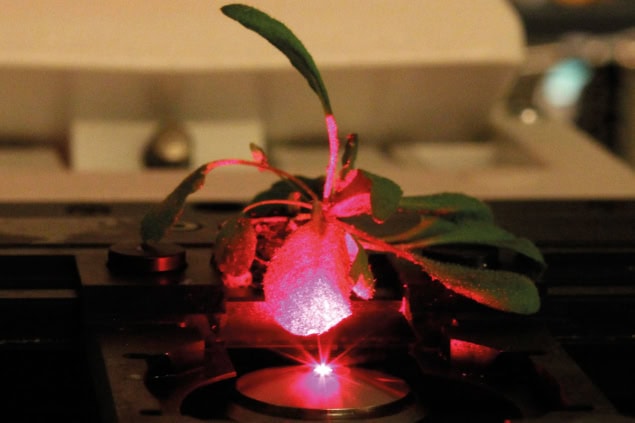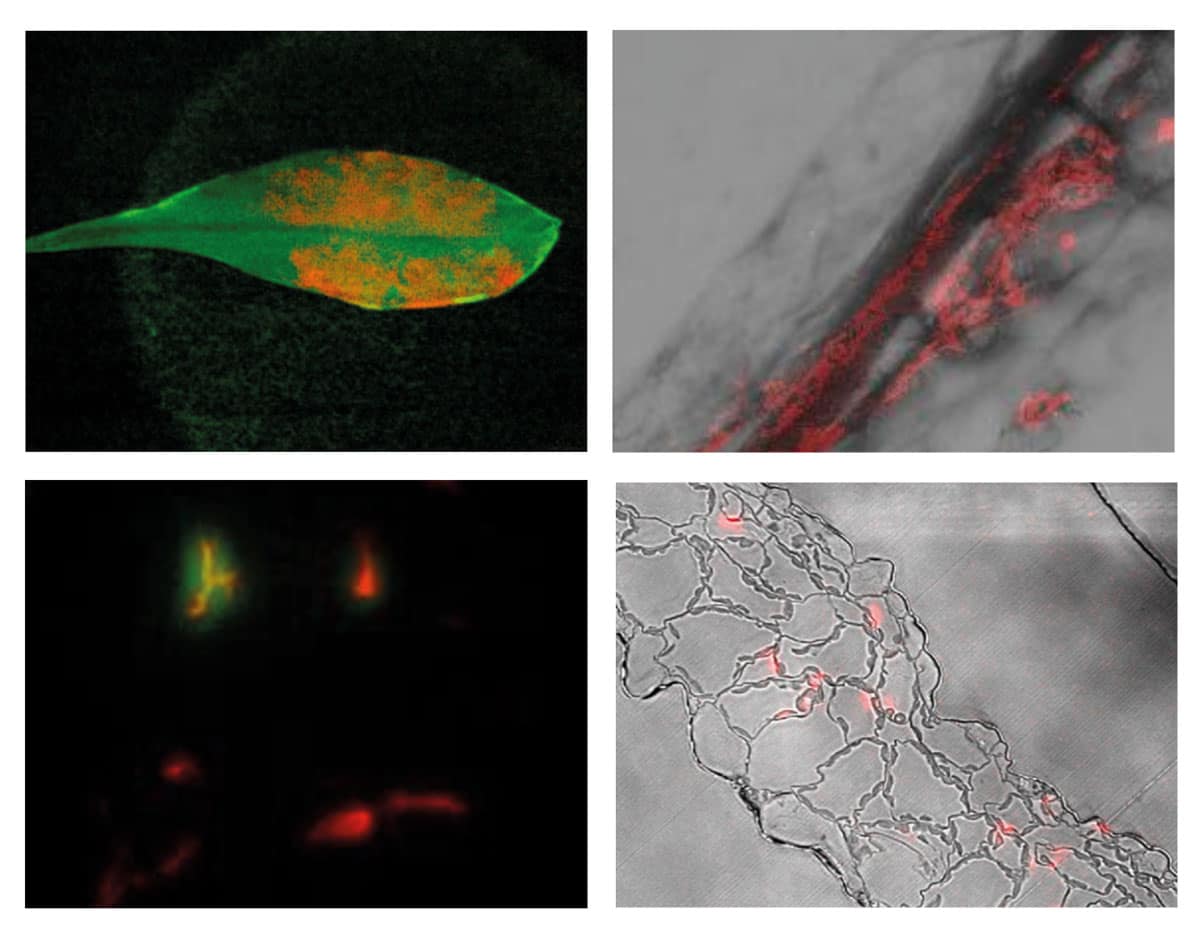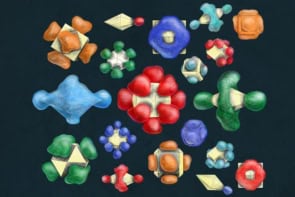Nanomaterials are being used to give plants novel and augmented functions, with potential applications ranging from self-healing materials to living electronics, report Michael Strano and Juan Pablo Giraldo

Imagine that you were to visit a distant planet and find its surface blanketed with sophisticated machines. These machines sense and respond to their environment, diagnose and repair themselves, and create their own fuel from their surroundings. As a technology-savvy earthling, you would be incredulous to learn that the only value seen in such machines was to grind them up, process and eat them – yet this is precisely what we do every day. Plants on Earth possess all of these diverse functions and more, but only now are we beginning to consider the potential of plants for new technologies.
Augmented technology
The nascent field of “plant nanobionics” seeks to harness known properties of plants to augment or reinvent human technology. By treating living plants as technological platforms we can learn how to integrate nanoparticles with plant-based materials to impart novel functions to devices. Sensors in the form of plants could sample their environment through transpiration and report the result via radio-frequency signals, for example, or we can imagine self‑repairing, plant-based photonic devices that serve as communications networks. Plants even have their own power source – photosynthesis, which has the added benefit of consuming carbon dioxide – and are made of cheap materials that are naturally recyclable.
The possibilities of plant nanobionics are potentially far-reaching. A world in which materials repair themselves using sunlight or where buildings in cities act as active carbon sinks would be transformative. Nanoelectronic devices parasitically wired and integrated into a plant’s internal machinery could draw power, store energy and communicate sensory information relating to water stress, chemical exposure, nutrient stress or ambient illumination. How realistic is this vision? While there are definite limitations to plant nanobionics, this is a new field with much unexplored territory and scope for surprise.
Consider photosynthesis from an engineering perspective. A plant chloroplast (the photosynthetic engine of the organism) can produce sugars at an average rate of 40 µg per square centimetre per hour. That is equivalent to 10% of the energy stored in a watch battery each day – not enough to power your smartphone or tablet, but sufficient to drive an active radio-frequency identification circuit to export information, an electrochemical sensor to generate information, or a luminescent beacon for signalling.
The stems of plants, which transport sap from the roots to the leaves via a bundle of conduits each being 10–100 μm across, are another natural engineering marvel that could be exploited for devices. The electrolyte-containing conduits have an electrical conductivity of 0.5 millisiemens per centimetre, which is more than 30 times higher than that of silicon at room temperature, therefore providing channels for parallel communications from the ground to the tips of leaves.
Furthermore, pressure drops induced in the xylem from evaporating water inside leaves can reach values of more than –3 MPa. This is similar in magnitude to the pressure drops that power the entire field of microfluidic devices, which today are typically provided by bulky external pumps.
These are just a few examples that reveal the potential of plants as engineering materials, but there is much more infrastructure within the plant that could be tapped for applications. Plant nanobionics is distinct from the now well-established field of biomimetics, in which engineers learn from natural systems to create new synthetic materials, because it seeks to incorporate living plants into the final device. In plant systems, the use of nanotechnology for this purpose has no precedent.
Merging disciplines
Working at the intersection of plant physiology and nanotechnology, we became interested in plant nanobionics in 2010 thanks to a research project in which we studied plant self-repair mechanisms during photosynthesis. Our goal was to mimic such repair in synthetic devices, and we successfully built self-assembled photo-electrochemical devices by combining carbon nanotubes into a plant’s photosystem. However, the project motivated us to investigate whether we could exploit existing functions of the plant’s natural machinery – such as self-repair and the conversion of solar energy into fuels – to create high performance, self-repairing solar cells.
Last year we reported a series of new techniques that allow nanoparticles to be delivered and localized within living plants and plant organelles, and we were able to demonstrate several novel functions that could emerge as a result (Nature Materials 13 400). Using extracted spinach chloroplasts and leaves from Arabidopsis plants, we found that single-walled carbon nanotubes (SWCNTs) augment both the light reactions of photosynthesis and biochemical detection functions in these species. Furthermore, we discovered that, under certain conditions, SWCNTs can be made to assemble within the chloroplast’s photosynthetic machinery, which has proven to be a powerful enabling technique.
Surprisingly, SWCNTs that are thousands of times longer than the thickness of a lipid bilayer penetrate the outer lipid envelopes of chloroplasts and are left trapped on the inside. Wrapped in highly charged molecules, the SWCNTs assemble within the chloroplast photosynthetic machinery via a mechanism we call lipid exchange envelope penetration (LEEP): the SWCNTs become coated with lipids that form the chloroplast envelopes, pulling nanotubes in as the membrane repairs itself and thereby trapping them inside. LEEP could potentially be used to make many new types of hybrid photosynthetic materials in plants, including those that absorb light at wavelengths across the electromagnetic spectrum or those that have chemo-protective capabilities against photo-damage. We demonstrated that SWCNTs can enhance the rates of photo-induced electron transport both in chloroplasts extracted from the plant-cell host and in leaves of living plants by up to 30% relative to controls.
The delivery of SWCNTs to living plants was performed by infiltration through the stomata, which are the pores that control gas exchange between leaves and the atmosphere. We also exploited this mechanism to deliver nano-sized particles of cerium oxide (known as “nanoceria”) inside chloroplasts, significantly reducing the levels of reactive oxygen species to values 28% lower than in control chloroplasts. Nanoceria particles act catalytically as potent scavengers of these damaging molecules, a bit like supercharged vitamin C, thus protecting the chloroplast protein complexes and significantly extending the lifetime of the plant.
We also showed that plants assembled with carbon nanotubes can act as chemical sensors that communicate by fluorescent signalling. These nanobionic plants report changes in the concentration of nitric oxide (a plant-signalling molecule and environmental pollutant) by modulating the near-infrared emission of nanoparticle sensors embedded within the leaf lamina. The modified plants are able to respond within seconds of exposure and are capable of detection sensitivities below one part per million in aqueous media. We envision such nanobionic plants replacing more expensive inorganic sensors based on electronics and plastics for the detection of explosives or environmental pollutants, for instance.

The discovery that SWCNTs can assemble within a plant’s photosynthetic machinery raises the possibility of biocompatible electrodes patterned within and on the surfaces of leaves and stems. These could be interfaced with plant tissues to produce electrical circuits for computation, electrochemical detection of molecules inside the plant, or external communication. This merging of synthetic and natural infrastructures is one of the central visions of plant nanobionics. A laccase–glucose oxidase electrode pair, for example, creates a biofuel cell that could syphon off stored glucose to electrically power the circuits. This could allow the circuit to monitor the plant’s photosynthetic output directly by quantifying the sugars that are the main products of photosynthesis.
Monitoring other plant signals is similarly intriguing. Abscisic acid, for instance, is a hormone produced by roots in response to dry soil conditions that controls plant transpiration by closing the stomatal aperture. We can therefore imagine nanoelectronic circuits that respond to plant chemical signals and control the water content of their environment, for example by generating a radio-frequency signal that activates an irrigation device in response to water stress.
We can even consider incorporating plant systems directly into our own building materials to provide added functionality. Since chloroplasts can perform the basic function of converting sunlight and carbon dioxide into sugars even when they are removed from a living plant cell, materials containing transplanted chloroplasts could potentially capture unwanted carbon dioxide from the atmosphere. For this to be possible, however, we first need to prevent the natural degradation of the “naked” chloroplasts caused by reactive oxygen species and other mechanisms when they are removed from the plant cell. At the Massachussetts Institute of Technology we have recently been working on the concept of a “hyperstable chloroplast” as an engineering material, perhaps based on chemo-protective nanoparticles such as nanoceria.
Calling all physicists
Such visions might at first seem a bridge too far. Plant nanobionics requires interdisciplinary research teams and strong collaboration between plant scientists and nanotechnology researchers to make it reality, but there is a wealth of scientific knowledge and technological potential to be gained on the way towards this goal. Enhancing crop yields and the productivity of algae biofuel, or creating novel hybrid photovoltaic and optical communication materials, are already widely studied technological goals. But some applications, such as authentic plant cyborg tissue, require completely new avenues of exploration.
There are many different scientific and engineering challenges for plant nanobionics in the decade ahead. We have shown that nanoparticles introduced to a plant can be trafficked to the chloroplasts in leaves via vascular infusion, but what about directing other nanoparticles to other plant organs or tissues to boost or introduce additional functions? Does a given nanoparticle with particular properties and coatings affect its transport within the plant? Such questions are still poorly understood, but will help to develop plant biocompatible circuits and optical communication materials.
To bridge the world of electronics and plants, we also need to understand the physical limitations imposed by the plant. We have to determine, for example, how electromagnetic interactions within and between nanomaterials affect the way that visible, infrared or radio-frequency waves interact with living plants. As with every new technology, safety studies should also be thoroughly conducted before taking nanobionic plants outside the laboratory. Nanotoxicity studies demonstrate that the behaviour of nanomaterials in living tissue depends a lot on the surface chemistry, aspect ratio, nanoparticle size and other properties. While studies in this area will help engineers to design additional biocompatible materials for the plant interface, many nanobionic applications – such as those designed to replace or enhance silicon, plastic and metal devices for communications, photonics or self-powered systems – do not involve ingestible nanoparticles.
There are seemingly endless opportunities and challenges in using nanotechnology to enhance and exploit the diverse functions of plants. One certainty, however, is that plant nanobionics requires the engagement of multidisciplinary teams of plant biologists, chemists, engineers and physicists alike.



